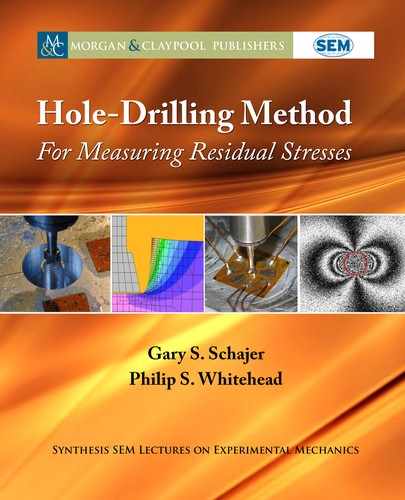6.8. RESIDUAL STRESS EXAMPLE: MACHINED, FORGED DISC 135
6.8 RESIDUAL STRESS EXAMPLE: MACHINED, FORGED
DISC
e disc nickel alloy disc shown in Figure 6.13a has been quenched and aged, resulting in sig-
nificant levels of residual stresses throughout the disc structure before rough machining. At
the side of the disc close to the bore, a 1/16” rosette (D) has been installed and drilled with
“fine” increments (16 m) close to the surface, becoming coarser at greater depths. Over the
depth range 100–500 m, the radial and circumferential stresses are distributed in a generally
uniform manner, as shown in Figure 6.13c; nominal stress levels here are around 100 MPa (ra-
dial) and 300 MPa (circumferential). Closer to the surface, the stress input from the machining
(lathe turning) process is clearly shown with tensile maxima in both radial and circumferential
directions at the first calculation increment. e tensile stress in the direction of machining ex-
ceeds 400 MPa while the radial stress does not exceed 200 MPa at this depth. In this instance,
the depth of material directly affected by the machining process appears to be within the first
100 m.
While indicating the general shape of the stress distributions and levels of near surface
stress gradients shown in Figure 6.13c, the Hole-Drilling Method with the equipment described
here is not capable of determining the magnitudes of extreme stresses that exist very close to the
surface in the first few microns. However, this result does provide a good illustration of how the
Integral Method deals with large near-surface stress gradients. e stress distributions show that
the near-surface stresses induced by the machining process are clearly tensile while sub-surface
stresses at this part of the disc structure (caused by previous thermal processing) are compressive.
6.9 RESIDUAL STRESS EXAMPLE: SURFACE PROCESS
SAMPLES
A series of titanium samples (50 mm 50 mm 10 mm thick) was prepared in which the
conditions of the material surface were as follows.
E1. Wire-EDM cut surface
E2. EDM surface; recast layer removed using a fine abrasive
E3. Shot-peened
E4. Shot peened (as E3) and then smoothed to remove 50% of the peening indentations
E5. Shot-peened and smoothed (as E4) followed by further fine abrasion to remove the outer
50 m of material.
Figure 6.14a shows a typical installation of a 1/32” pattern rosette on the surface of shot-
peened sample 3. One gauge was installed on each of the samples and drilled using “fine” near-
surface increments of 16 m (becoming coarser with increasing depth). e resulting stress

136 6. EXAMPLE PRACTICAL PROCEDURES AND RESULTS
(b)(a)
(c)
0 Depth 100 µm 200 300 400 500
Residual Stresses MPa
600
400
200
0
-200
-400
-600
-800
Radial Stress
Circumferential Stress
D
Figure 6.13: Machined, forged disc sample, gauge installation, and stress distributions (photos
courtesy of Stresscraft Ltd.).
distributions (stress direction parallel to gauge element 1) are shown in Figure 6.14b. Features
of the stress distributions include:
• low levels of sub-surface stresses in all samples; this helps the interpretation of the contri-
butions of stresses made by the surface processes in this series;
• tensile stresses close to the surface of the wire-EDM cut re-cast layer (sample E1) in excess
of 600 MPa; the tensile stress extends to a depth of 40 m. Removal of this layer using
fine abrasion and water coolant (sample E2), eliminates the near-surface tension;
• subsequent shot-peening of the sample results in compressive stresses exceeding 800 MPa
over the depth range to 50 m and extending to a depth of 150 m (sample E3). Care-
..................Content has been hidden....................
You can't read the all page of ebook, please click here login for view all page.
